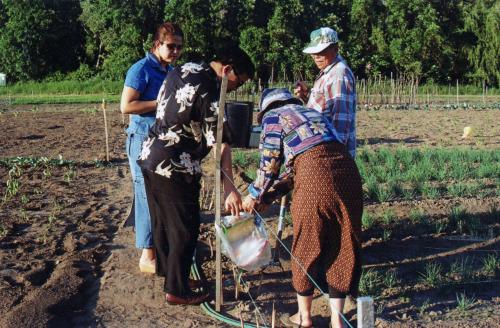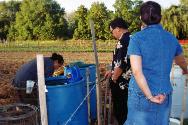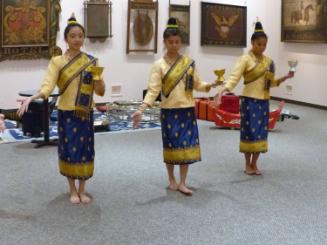Lao Gardening, Farmington and West Hartford
SubjectPortrait of
Manola Sidara
(Laotian)
SubjectPortrait of
Howard Phengsomphone
(Laotian)
Date2005
Mediumphotographic prints
ClassificationsGraphics
Credit LineConnecticut Cultural Heritage Arts Program collections
CopyrightIn Copyright
Object number2015.196.406.1-.17
Description2015.196.406.1-.5: Images of Lao gardeners tending their fields that are part of the Kolp Community Garden Plots in Farmington on Meadow Road along the banks of the Farmington River.
2015.196.406.6-.8: Images of the Lao community fields and their bean poles that are part of the Kolp Community Garden Plots in Farmington on Meadow Road along the banks of the Farmington River.
2015.196.406.9: Image of Manola Sidara in the Lao community garden that is part of the Kolp Community Garden Plots in Farmington on Meadow Road along the banks of the Farmington River.
2015.196.406.10: Image of Lao gardeners tending their fields that are part of the Kolp Community Garden Plots in Farmington on Meadow Road along the banks of the Farmington River.
2015.196.406.11: Image of Manola Sidara and Howard Phengsomphone in the Lao community garden that is part of the Kolp Community Garden Plots in Farmington on Meadow Road along the banks of the Farmington River.
2015.196.406.12: Image of Lao gardeners tending their fields that are part of the Kolp Community Garden Plots in Farmington on Meadow Road along the banks of the Farmington River.
2015.196.406.13: Image of Manola Sidara in the Lao community garden that is part of the Kolp Community Garden Plots in Farmington on Meadow Road along the banks of the Farmington River.
2015.196.406.14-.17: Images of a Lao man tending plants in pots outside of East-West Grille in West Hartford.
NotesSubject Note: The Larry Kolp Community Garden Plots are located in Farmington, Connecticut along the Farmington River on Meadow Road. These plots ae available to Farmington residents and others to plant during the growing season. For many years a group from the Lao community has planted a garden here, growing Laotian and other vegetables, flowers, and herbs. They donate a portion of their produce to local Lao temples for the monks’ food. During the time when she owned and operated East West Grille on New Park Avenue in West Hartford, chef Manola Sidara grew vegetables, herbs, spices, and flowers that she used in the restaurant.2015.196.406.6-.8: Images of the Lao community fields and their bean poles that are part of the Kolp Community Garden Plots in Farmington on Meadow Road along the banks of the Farmington River.
2015.196.406.9: Image of Manola Sidara in the Lao community garden that is part of the Kolp Community Garden Plots in Farmington on Meadow Road along the banks of the Farmington River.
2015.196.406.10: Image of Lao gardeners tending their fields that are part of the Kolp Community Garden Plots in Farmington on Meadow Road along the banks of the Farmington River.
2015.196.406.11: Image of Manola Sidara and Howard Phengsomphone in the Lao community garden that is part of the Kolp Community Garden Plots in Farmington on Meadow Road along the banks of the Farmington River.
2015.196.406.12: Image of Lao gardeners tending their fields that are part of the Kolp Community Garden Plots in Farmington on Meadow Road along the banks of the Farmington River.
2015.196.406.13: Image of Manola Sidara in the Lao community garden that is part of the Kolp Community Garden Plots in Farmington on Meadow Road along the banks of the Farmington River.
2015.196.406.14-.17: Images of a Lao man tending plants in pots outside of East-West Grille in West Hartford.
Subject Note: Connecticut was a major resettlement site for Southeast Asians in the 1980's. The Lao population numbers over 3000, living primarily in urban areas such as New Britain, Bridgeport, East Hartford, and Danbury and for a time in the 1990s-2007, in rural eastern Connecticut. While many Lao have found employment in factories, service industries, farming, and trades such as food, they continue to face barriers of language, lack of education, and lower income levels, all against a common backdrop of serious emotional wounds from the Viet Nam War era. Youth aged 10 - 19 years old have been by far the largest age group among Connecticut Southeast Asians. Maintaining young peoples’ awareness of heritage, culture, values, and language is a major goal of Lao leaders and parents. The Lao community sustains its traditional cultural practices in several ways. Several temples around the state provide gathering places where Buddhist monks and nuns offer spiritual services and cultural festivals. The largest temple is in Morris, where the resident monk Khoutavong has created exquisite Buddhist statues and traditional architecture with symbolic carvings, ornamentation, and shrines. Dancer and educator Manola Sidara developed and has directed Lao Narthasin, a traditional dance group now in its third generation of dancers. They perform classical, folk, and social dances that highlight cultural values such as respectful behavior and appreciation for elders. Manola also specializes in creating ceremonial decorations that express wellness, spirituality, and bonding during community celebrations, and she also promotes health and healing through her work as a master chef. The Lao Association of Connecticut formed in 1980 to unite the community and assist in economic development, cultural preservation, education, and health. For many years LAC offered classes in language, history, food and medicine, verbal arts, traditional music, and singing at Jefferson School in New Britain, and the group organizes several heritage festivals each year at the Morris temple that are attended by hundreds of Lao people. Other Lao community groups around the state also develop and present spiritual and cultural programs as well as health initiatives.
Subject Note: The Lao Association of Connecticut (LAC) is a community-based non-profit formed in 1980 to provide assistance to Lao-Americans in areas of need such as cultural preservation, education, advocacy, translation, and access to services. Its Board of Directors is comprised of senior members of the Lao community, including educators and artists. LAC was instrumental in developing Lao Saturday School in collaboration with Jefferson School in New Britain, starting in 1994 and running for several years, offering classes in Lao language, history, and arts as well as ESOL and citizenship to adults. LAC sponsors an annual New Year Celebration in April that brings Lao together from all over Connecticut, held for many years in New Britain and elsewhere in temples around Connecticut. LAC has also organized events and projects that serve the community; the group collaborated on the Southeast Asian Problem Gambling Project run by the Department of Mental Health and Addiction Services, as well as other health initiatives. LAC also worked with CCHAP and other Southeast Asian communities to recruit students and parent volunteers for after-school classes, involve students and teachers in community activities; and introduce artists from the other communities to each other.
Biographical Note: Manola Sidara is a Lao dance educator and community activist whose life has been devoted to serving her community. Born in 1969 in Vientiane, Laos, Manola joined the National Dance School at the age of five, along with her sister. After her family fled Laos, she continued learning traditional dance with master dancer Sone Norasing in Colorado until moving to Connecticut in 1989. From her grandmother and aunts Manola learned to make pah khuane, the ornaments of bamboo leaves and flowers which are part of every Lao ceremony and celebration in both temple and home. She worked as a wedding consultant, organizing all the arrangements for traditional Lao weddings, and became known as a brilliant cake decorator. Manola helped to produce the exhibit The Ties That Bind: Southeast Asian Wedding Traditions at the Institute for Community Research (ICR) in 1995. In 1999-2000 she served as the Bilingual Program Assistant at Garfield School in Bridgeport, teaching ESOL, computers, and cultural awareness to elementary school children both Lao and Latino. Manola taught traditional dance at the Lao Saturday School in New Britain from its inception. With her high-school age students from the school, Manola formed the Lao Narthasin Dance Troupe, instructing the members in classical Laotian dance, folk dances of different ethnic groups in Laos, and traditional values and manners such as respectful behavior, honoring elders, and service to the family and community. The dance group, which has performed throughout Connecticut and Rhode Island at cultural centers and Lao temples, now includes a third generation of dancers. From 1998 to 2001 Manola was the New Britain Coordinator for the Urban Artists Initiative, a statewide training program run by the Connecticut Commission on the Arts and the Institute for Community Research. In 2001 Manola received an award from the Lao Association of CT at New Year for her work with the Lao Narthasin dancers and was selected as a CT Commission on the Arts Master Teaching Artist. In 2011 Manola coordinated the community oral history project After the Trauma: Holocaust Survivors and Laotian Refugees Confront the Past, displayed at the University of Hartford. Manola is also known as a master chef at East West Grille, her award-winning and beloved Lao-Thai restaurant on New Park Avenue in Hartford from 2000-2019, and the East-West Grille Food Truck. Manola is very active in assisting the Lao Temple in Morris, CT, with cultural programming, social service, and providing food for the monks and their ceremonies. For Manola, her tireless activities in dance, education, ceremonial decorations, and cooking all promote wellness, spirituality, bonding, and healing.
Biographical Note: Houmpheng (Howard) Phengsomphone retired from a long career as a counselor and administrator of several federal and state substance abuse and violence prevention projects in Rhode Island and Connecticut. In 1999 U.S. Department of Health selected his program as one of the best refugee services for youth and families. He has spoken at national conferences and universities on his work with gangs and violence prevention. A survivor of imprisonment by the Communist regime in Laos, Howard’s volunteer community involvement has been his way of supporting Lao in America who still struggle with emotional and cultural losses from the war and its aftermath. He served on the Rhode Island Coalition for Affirmative Action, the Southeast Asian Advisory Council for Parents and Schools (RI), the Providence Mayor’s Council on Human Relations, and the Governor’s (RI) Juvenile Justice Commission. He has been a Board Member of the Lao Association of CT since its inception, and was a founder, along with his wife Sue (Sisimphone), and teacher of culture and history at Lao Saturday School in New Britain for years beginning in 1994. Howard has spearheaded the collaborative development of expanded cultural heritage opportunities for Lao teens in Connecticut, leading to a partnership with CCHAP and Cambodian, Hmong, and Lao cultural leaders to offer afterschool programs, funded by the National Endowment for the Arts. The longtime Executive Director of the Lao Association of Connecticut, he continues to work in the area of culture, health, history, and community service for the Lao community.
Additional audio, video, and photographic materials exist in the archive relating to this community and its artists.
Cataloging Note: This project was made possible in part by the Institute of Museum and Library Services MA-245929-OMS-20.
Status
Not on viewThongchine Thongsythavong
1995






























